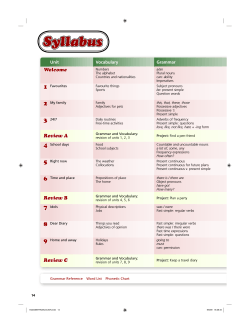
Hw4 solution keys
CS150 Homework 4
Solution keys,
winter, 2015
Due 5/24
Problem 1. (10 points)
Construct a CFG for the set of all ternary strings of the form 0i 1j 2k , where i + j = k.
S → 0S2 | X
X → 1X2 | ²
1
Problem 2. (Exercise 5.2.1, 10 points)
For the grammar and each of the strings in Exercise 5.1.2, give parse tree.
Exercise 5.1.2: The following grammar generates the language of regular
expression 0∗ 1(0 + 1)∗ :
S → A1B
A → 0A | ²
B → 0B | 1B | ²
(a) 00101.
(b) 1001.
(c) 00011.
(a) 00101
(b) 1001
S
S
A
0
1
A
0
0
A
²
A
B
1
B
S
1
²
B
(c) 00011
B
0
A
B
0
²
0
B
1
2
A
0
B
²
1
B
1
²
A
0
A
²
B
Problem 3. (Exercise 5.4.7, 20 points)
The following grammar generate prefix expressions with operands x and y and binary
operators +, −, and ∗:
E → +EE | ∗EE | −EE | x | y
(a) Find leftmost and rightmost derivations, and a derivations tree for the string +*-xyxy.
(b) Prove that this grammar is unambiguous. (Hint: show that the leftmost derivation
is unique for any given input string.
(a) Leftmost derivation:
E ⇒ +EE
Rightmost derivation:
E ⇒ +EE
rm
lm
⇒ +Ey
⇒ + ∗ EEE
rm
lm
⇒ + ∗ EEy
⇒ + ∗ −EEEE
lm
rm
⇒ + ∗ −xEEE
lm
rm
⇒ + ∗ −xyEE
rm
⇒ + ∗ −xyxE
rm
⇒ + ∗ −xyxy
rm
⇒ + ∗ Exy
⇒ + ∗ −EExy
lm
⇒ + ∗ −Eyxy
lm
⇒ + ∗ −xyxy
lm
E
+
E
E
∗
E
E
y
−
E
E
x
x
y
(b) Proof. In this grammar, the application of each rule generates a string starting
with a unique terminal symbols (+, ∗, −, x, or y). For any string w that belongs to
the CFL, when we consider a leftmost variable E in the leftmost derivation of the
string, there is only one rule that can be used to continue the derivation. This rule
is uniquely determined by the next symbol in w to be derived. So there is only one
leftmost derivation for w and hence the unambiguity of the grammar.
¤
3
Problem 4. (Exercise 6.1.1 (b)(c), 10 points)
Suppose the PDA P = ({q, p} , {0, 1} , {Z0 , X} , δ, q, Z0 , {p}) has the following transition
function:
1. δ(q, 0, Z0 ) = {(q, XZ0 )}.
2. δ(q, 0, X) = {(q, XX)}.
3. δ(q, 1, X) = {(q, X)}.
4. δ(q, ², X) = {(p, ²)}.
5. δ(p, ², X) = {(p, ²)}.
6. δ(p, 1, X) = {(p, XX)}.
7. δ(p, 1, Z0 ) = {(p, ²)}.
Starting from the initial ID (q, w, Z0 ), show all the reachable ID’s when the input w is:
(b) 0011.
(c) 010.
(b) 0011:
(q, 0011, Z0 )
(q, 011, XZ0 )
(p, 011, Z0 )
(q, 11, XXZ0 )
(p, 11, XZ0 )
(q, 1, XXZ0 )
(p, 1, XZ0 )
(p, 11, Z0 )
(p, 1, ²)
(p, 1, XXZ0 )
(p, ², XXXZ0 )
(p, 1, Z0 )
(p, ², ²)
(p, ², XXZ0 )
(q, ², XXZ0 )
(p, ², XZ0 )
(p, ², Z0 )
4
(c) 010:
(q, 010, Z0 )
(q, 10, XZ0 )
(p, 10, Z0 )
(q, 0, XZ0 )
(p, 0, Z0 )
(q, ², XXZ0 )
(p, ², XZ0 )
(p, 0, ²)
(p, ², Z0 )
5
Problem 5. (Exercise 6.2.1 (b)(c), 20 points)
Design a PDA to accept each of the following languages. You may accept either by
final state or by empty stack, whichever is more convenient.
(b) The set of all strings of 0’s and 1’s such that no prefix has more 1’s than 0’s.
(c) The set of all strings of 0’s and 1’s with an equal number of 0’s and 1’s.
(b) PDA P = ({q, p} , {0, 1} , {Z0 , X} , δ, q, Z0 , {p}):
δ(q, 0, Z0 ) = {(q, XZ0 )}
δ(q, 0, X) = {(q, XX)}
δ(q, 1, X) = {(q, ²)}
δ(q, 0, X) = {(p, X)}
δ(q, ², Z0 ) = {(p, Z0 )}
(c) PDA P = ({q, p} , {0, 1} , {Z0 , X, Y } , δ, q, Z0 , {p}):
δ(q, 0, Z0 ) = {(q, XZ0 )}
δ(q, 0, X) = {(q, XX)}
δ(q, 0, Y ) = {(q, ²)}
δ(q, 1, Z0 ) = {(q, Y Z0 )}
δ(q, 1, Y ) = {(q, Y Y )}
δ(q, 1, X) = {(q, ²)}
δ(q, ², Z0 ) = {(p, Z0 )}
6
© Copyright 2025








